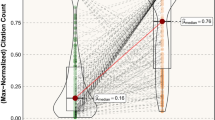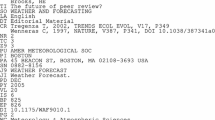Abstract
Peer review and citation metrics are two means of gauging the value of scientific research, but the lack of publicly available peer review data makes the comparison of these methods difficult. Mathematics can serve as a useful laboratory for considering these questions because as an exact science, there is a narrow range of reasons for citations. In mathematics, virtually all published articles are post-publication reviewed by mathematicians in Mathematical Reviews (MathSciNet) and so the data set was essentially the Web of Science mathematics publications from 1993 to 2004. For a decade, especially important articles were singled out in Mathematical Reviews for featured reviews. In this study, we analyze the bibliometrics of elite articles selected by peer review and by citation count. We conclude that the two notions of significance described by being a featured review article and being highly cited are distinct. This indicates that peer review and citation counts give largely independent determinations of highly distinguished articles. We also consider whether hiring patterns of subfields and mathematicians’ interest in subfields reflect subfields of featured review or highly cited articles. We re-examine data from two earlier studies in light of our methods for implications on the peer review/citation count relationship to a diversity of disciplines.

Note. Data of individual students in scatterplot (left). The same data in bins of size ten and in quartiles


Similar content being viewed by others
Notes
Others are based on altmetric measures or peer review such as mentions on social media, patented based measures, grant funding, or prizes and awards.
See Gilbert (1977) for references.
See Gilbert (1977) for references.
Article publication dates were 1993 to 2004.
The list of featured review articles is no longer available from the American Mathematical Society. We found featured review articles through the analysis of the review texts.
Using a sample of 6,000 and assuming that WOS mathematics category articles are included in MathSciNet.
Formerly, the committee also included a representative of the Institute for Mathematical Statistics.
References
Aksnes, D. W., Langfeldt, L., & Wouters, P. (2019). Citations, citation indicators, and research quality: An overview of basic concepts and theories. SAGE Open, 9(1), 1–17. https://doi.org/10.1177/2158244019829575.
American Mathematical Society. (1995). Editorial Statement. Mathematical Reviews, 95(a), 1.
American Mathematical Society. (2019). About MathSciNet. Retrieved August 12, 2019 from https://mathscinet.ams.org/mathscinet/help/about.html?version=2.
Barabási, A. L., & Albert, R. (1999). Emergence of scaling in random networks. Science, 286(5439), 509–512.
Bensman, S. J., Smolinsky, L., & Pudovkin, A. I. (2010). Mean citation rate per article in mathematics journals: Differences from the scientific model. Journal of the American Society for Information Science and Technology, 61(7), 1440–1463.
Bertocchi, G., Gambardella, A., Jappellic, T., Nappi, C. A., & Peracchi, F. (2015). Bibliometric evaluation vs. informed peer review: Evidence from Italy. Research Policy, 44, 451–546.
Bornmann, L. (2017). Measuring impact in research evaluations: A thorough discussion of methods for, effects of and problems with impact measurements. Higher Education, 73(5), 775–787.
Bornmann, L., & Daniel, H.-D. (2008a). What do citation counts measure? A review of studies on citing behavior. Journal of Documentation, 64(1), 45–80.
Bornmann, L., & Daniel, H.-D. (2008b). The effectiveness of the peer review process: Inter-referee agreement and predictive validity of manuscript refereeing at Angewandte Chemie. Angewandte Chemie International Edition, 47(38), 7173–7178.
Bornmann, L., & Osório, A. (2019). The value and credits of n-authors publications. Journal of Informetrics, 13(2019), 540–554.
Campanario, J. M. (1998). Peer review for journals as it stands today—part 1. Science Communication, 19(3), 181–211.
Chedzoy, O. B. (2006). Phi-Coefficient. Wiley Online Library. John Wiley & Sons, Inc.
Cohen, J. (1960). A coefficient of agreement for nominal scales. Educational and Psychological Measurement, 20(1), 37–46. https://doi.org/10.1177/001316446002000104.
Cronin, B. (2005). The hand of science: Academic writing and its rewards. Scarecrow press.
Eysenck, H. J., & Eysenck, S. B. G. (1992). Peer review: Advice to referees and contributors. Personality and Individual Differences, 13, 393–399.
Garfield, E. (1962). Can citation indexing be automated? Essays of an Information Scientist, 1, 84–90.
Garfield, E. (1979). Citation indexing, its theory and application in science, technology, and humanities. John Wiley & Sons Inc.
Gilbert, G. N. (1977). Referencing as persuasion. Social Studies of Science, 7, 113–122.
Jackson, J. L., Srinivasan, M., Rea, J., Fletcher, K. E., & Kravitz, R. L. (2011). The validity of peer review in a general medicine journal. PLoS ONE, 6(7), e22475. https://doi.org/10.1371/journal.pone.0022475.
Kravitz, R. L., Franks, P., Feldman, M. D., Gerrity, M., Byrne, C., & Tierney, W. M. (2010). Editorial peer reviewers’ recommendations at a general medical journal: Are they reliable and do editors care? PLoS ONE, 5(4), e10072. https://doi.org/10.1371/journal.pone.0010072.
Langfeldt, L. (2001). The decision-making constraints and processes of grant peer review, and their effects on the review outcome. Social Studies of Science, 31, 820–841.
Lee, C. J., Sugimoto, C. R., Zhang, G., & Cronin, B. (2013). Bias in peer review. Journal of the American Society for Information Science and Technology, 64(1), 2–17.
Li, X., & Thelwall, M. (2012). F1000, Mendeley and traditional bibliometric indicators. In Archambault, É., Gingras, Y., Larivière, V. (Eds.), Proceedings of 17th International Conference on Science and Technology Indicators (pp. 541–551). OST and Science-Metrix.
MacRoberts, M. H., & MacRoberts, B. R. (2018). The mismeasure of science: Citation analysis. Journal of the Association for Information Science and Technology, 69, 474–482. https://doi.org/10.1002/asi.23970.
Mallapaty, S. (2018, January 30). Paper authorship goes hyper. Retrieved August 14, 2019, from https://www.natureindex.com/news-blog/paper-authorship-goes-hyper.
McHugh, M. L. (2012). Interrater reliability: The kappa statistic. Biochemia Medica, 22(3), 276–282.
McHugh, M. L. (2018). Phi Correlation Coefficient. In B. B. Frey (Ed.), The SAGE encyclopedia of educational research, measurement, and evaluation. SAGE Publications Inc.
Merton, R. K. (1988). The Matthew effect in science, II: Cumulative advantage and the symbolism of intellectual property. Isis, 79(4), 606–623.
Moed, H. F. (2005). Citation analysis in research evaluation. Springer.
Moed, H. F. (2017). Applied evaluative informetrics. Springer.
National Research Council. (2009). A Guide to the Methodology of the National Research Council Assessment of Doctorate Programs. The National Academies Press.
National Research Council. (2011). A data-based assessment of research doctoral programs in the United States. The National Academies Press.
National Science Board (2010). Science and Engineering Indicators 2010. (NSB 10–01). National Science Foundation.
Nicholas, D., Watkinson, A., Jamali, H. R., Herman, E., Tenopir, C., Volentine, R., et al. (2015). Peer review: Still king in the digital age. Learned Publishing, 28, 15–21. https://doi.org/10.1087/20150104.
Patterson, M. S., & Harris, S. (2009). The relationship between reviewers’ quality-scores and number of citations for papers published in the journal physics in medicine and biology from 2003–2005. Scientometrics, 80(2), 345–351.
Peters, D. P., & Ceci, S. J. (1982). Peer-Review Practices of Psychological Journals: The Fate Of Accepted, Published Articles, Submitted Again. Behavioral and Brain Sciences, 5(2), 187–195.
Price, D. D. S. (1976). A general theory of bibliometric and other cumulative advantage processes. Journal of the American Society for Information Science, 27(5), 292–306.
Rothwell, P. M., & Martyn, C. N. (2000). Reproducibility of peer review in clinical neuroscience: Is agreement between reviewers any greater than would be expected by chance alone? Brain, 123(9), 1964–1969.
Simon, H. A. (1955). On a class of skew distribution functions. Biometrika, 42(3/4), 425–440.
Smolinsky, L., & Lercher, A. (2012). Citation rates in mathematics: a study of variation by subdiscipline. Scientometrics, 91, 911–924. https://doi.org/10.1007/s11192-012-0647-3.
Smolinsky, L., & Lercher, A. (2020). Co-author weighting in bibliometric methodology and subfields of a scientific discipline. Journal of Data and Information Science, 5(3), 84–96.
Smolinsky, L., Lercher, A., & McDaniel, A. (2015). Testing theories of preferential attachment in random networks of citations. Journal of the Association for Information Science and Technology, 66(10), 2132–2145.
Storer, N. W. (1973). Introduction. In R. K. Merton (Ed.), The sociology of science: Theoretical and empirical investigations. University of Chicago press.
Tomkins, A., Zhang, M., & Heavlin, W. D. (2017). Reviewer bias in single-versus double-blind peer review. Proceedings of the National Academy of Sciences of the United States of America, 114(48), 12708–12713. doi:https://doi.org/10.1073/pnas.1707323114
Wainer, J., & Vieira, P. (2013). Correlations between bibliometrics and peer evaluation for all disciplines: The evaluation of Brazilian scientists. Scientometrics, 96, 395–410. https://doi.org/10.1007/s11192-013-0969-9.
Waltman, L., & Costas, R. (2014). F1000 recommendations as a potential new data source for research evaluation: a comparison with citations. Journal of the Association for Information Science and Technology, 65(3), 433–445.
Wouters, P. (1999). Beyond the Holy Grail: From citation theory to indicator theories. Scientometrics, 44, 561–580.
Acknowledgements
The authors are grateful to an anonymous reviewer whose questions and suggestions prompted the authors to clarify the implications of the study.
Funding
Daniel S. Sage was partially funded by the National Science Foundation (Grant No. DMS 1503555) and the Simons Foundation (Grant No. 637367).
Author information
Authors and Affiliations
Corresponding author
Rights and permissions
About this article
Cite this article
Smolinsky, L., Sage, D.S., Lercher, A.J. et al. Citations versus expert opinions: citation analysis of featured reviews of the American Mathematical Society. Scientometrics 126, 3853–3870 (2021). https://doi.org/10.1007/s11192-021-03894-2
Received:
Accepted:
Published:
Issue Date:
DOI: https://doi.org/10.1007/s11192-021-03894-2




